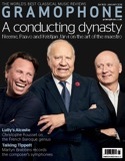Texte paru dans: / Appeared in: |
|
|
Outil de traduction (Très approximatif) |
|
|
Reviewer:
Peter Quantrill
There are strong arguments for opening out the themes of the Passion by means not of a staging transplanted from church to opera house, as has been attempted in recent years, but through movement. In this choreographed Passion there are two discrete but overlapping layers of action. The musicians concentrate on their given roles (with a very few, telling exceptions), thus obviating the kind of coordination problems which beset Katie Mitchell’s production at Glyndebourne, while dancers are freed to respond as much to Bach’s music as to the narrative at its source. Those arguments are justified here by Team Rademann: Hans-Christian, conductor of many fine choral recordings on Carus and Harmonia Mundi, and his wife Friederike, the choreographer whose idea it was to gather 100 children from schools in the Stuttgart area and teach them to dance. Bach’s elaborated setting of St Matthew is peculiarly suited to such an approach. The distance (and the monumental sense of space) between the two pairs of ensembles, written into their parts, is respected here by placing them at opposite corners of the stage; Rademann leads Orchestra/Choir 1, the Evangelist and Christus from front left. Thus the dancers occupy both the physical and imaginative space between them, at the heart of the music. In his booklet note the conductor approves and embraces René Jacobs’s notion of Orchestra/Choir 2 as an echo of the first ensemble. The filming conveys this, as cameras track between dancers and musicians, but the audio mix sandwiches them back together. Powerful musical values underpin the enterprise. Somewhat ironically given that the stage is filled with young people, the chorale melody in the opening chorus is sung by adults from the excellent Gächinger Cantorey, but their contribution is fitted to this vigorously pointed account, dynamically disposed in such a way that contrasts arise not from fussy nuancing within parts but the adding or subtracting of them in a way familiar from historically sensitive performances of keyboard music from the era, whether organ or harpsichord, and anchored by an unmannered, broad-grained continuo ensemble. The vocal soloists are all excellent, fairly extrovert whether in a mode of declamation or confession; Benno Schachtner’s alto and Benedikt Kristjánsson’s Evangelist are most vividly drawn and sung.
Friederike Rademann herself
appears in complement to Schachtner at the structural apex of the Passion,
though her elegantly phrased convulsions mirror the violin obbligato of ‘Erbarme
dich’. Such naturalistic responses to the shape of the music convince me less
than the powerful sense of community in her charges. The gestures are
unpretentious – gathering in an open circle for a Quaker communion, and in a
tight bunch for the congress of chief priests – but always tied to the text: the
chorales are especially effective in this regard, to the point of Friederike
grasping her bruised heel as the Penitent sinner reflects upon his guilt
inherited from Adam. Ancient, pan-cultural gestures of keening and mourning are
deployed in tune with Picander’s frequent recourse to the imagery of weeping,
not least in the Passion’s great outer pillars; and tears would be an entirely
understandable response from the other side of the screen. |
|




